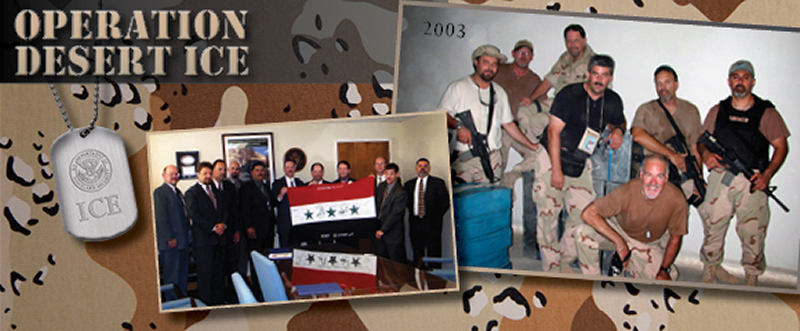Operation Desert ICE exemplifies new agency's broad mandate in 2003
In 2003, 15 agents from what would eventually become, U.S. Immigration and Customs Enforcement (ICE) deployed to Iraq, three days after the agency's creation, in a campaign dubbed Operation Desert ICE.
Upon their arrival, the agents - Abdul Adada, Eric Andreucci, Mike Bridgeman, Ramsey Corbin, Claude Davenport, Dave Denton, Mark Garrand, Ingolf Hack, Craig Healy, Sean McElroy, Steve Mocsary, Kevin Power, Bill Puff, George Rogers and Robert Sanchez - found that their agency was so new that a number of their counterparts had never heard of ICE.
Operating on a 90-day timeframe, the agents completed a number of investigations, ranging from counter-proliferation to illicit finance to cultural property and antiquities investigations.
"Prior to 2003, the U.S. Customs Service (one of ICE's legacy agencies along with the Immigration and Naturalization Service) was involved in numerous investigations involving companies illegally transshipping equipment to Iraq despite the export restrictions and embargos," said Power.
"It was felt that if agents could find U.S. equipment in Iraq, then we would be able to backtrack exactly how it got there. This was proven when ICE agents in Iraq documented several U.S.-made patrol boats that were illegally exported to Iraq and were able to prosecute the parties involved," added Power, now a Homeland Security Investigations (HSI) special agent out of Tampa.
The team of agents made history with its illicit finance investigations, at one point becoming the first to document Hussein's scamming of billions of U.S. dollars through the United Nations' "Oil for Food" program. By interviewing key Iraqi government officials, agents were also able to track much of Hussein's secret U.S. funds and recover an additional $32 million hidden in a house in Baghdad. The monies were subsequently returned to the interim Iraqi government.
Through its cultural property and antiquities investigations, the team of agents recovered Iraqi treasures, and investigated the looting of the Iraq National Museum following the fall of the Hussein regime. The team volunteered to lead this mission, and scoured Baghdad in search of more than 17,000 items that chronicled the region's 7,000 years of civilization. Agents electronically scanned the museum's inventory lists and manifests to determine which items were missing, and quickly determined that most of the museum's artifacts had been hidden by the staff.
Eventually, they were able to recover many of the items that were looted by cultivating sources among the Iraqi populace. Agents were also able to send information about looted artifacts to other countries to help recover them if they crossed their borders.
In the 10 years that have passed since those 15 agents conducted that operation, ICE has continued to build on its successes through a variety of national and global investigations. Today, ICE finds itself the largest investigative arm in DHS and a world-renowned law enforcement agency.
"For me personally, I was extremely proud of my agency when we stepped up on a national stage and sent 15 agents along with other elements of national power to Iraq," said Power. "To see how the team came together under extreme conditions and did our job to the best of our abilities - that was a great start for this agency."


